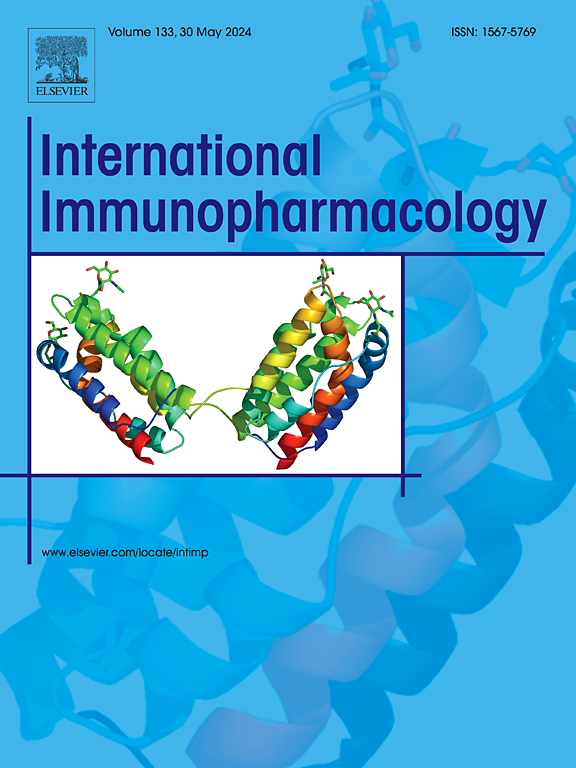新型冠状病毒感染肾移植受者外周血淋巴细胞亚群及抗体特征
IF 4.8
2区 医学
Q2 IMMUNOLOGY
引用次数: 0
摘要
背景:外周淋巴细胞亚群在多种疾病中发挥重要作用。然而,肾移植受者(KTRs)在新型冠状病毒肺炎(COVID-19)中的作用尚不清楚。本研究探讨外周血淋巴细胞亚群对KTRs合并COVID-19严重程度的预测价值以及抗体与淋巴细胞水平的相关性。方法:选取2022年12月至2023年2月收治的肾移植合并COVID-19患者84例。根据严重程度分为轻度组(n = 49)和重度组(n = 35)。采用logistic回归方法建立KTRs合并COVID-19的临界风险预测模型。采用受试者特征曲线(ROC)、校正图和临床决策曲线分析(DCA)评估该模型的鉴别、校正和临床应用价值。采用Spearman相关检验检验抗体与各项免疫指标之间的关系。结果:除CD4+HLA-DR+ T细胞增加外,重症组CD3+、CD4+、CD8+ T细胞亚群数量均低于轻症组(P +/淋巴细胞(%))+ 0.064× (CD4+HLA-DR+/ CD4+ T细胞(%))+ (-0.040)× (CD14+HLA-DR+/单核细胞(%))。预测模型的ROC曲线下面积(AUC)为0.779 (95% CI 0.679 ~ 0.879, P = 0.001)。截断值为0.308,预测敏感性为0.829 (95% CI 0.657 ~ 0.928),特异性为0.653 (95% CI 0.503 ~ 0.779)。Logistic回归分析显示,CD4+ T细胞中CD4+HLA-DR+ T细胞百分比的增加是肾移植受者COVID-19严重程度的危险因素,而淋巴细胞中CD3+ T细胞和CD14+单核细胞中CD14+HLA-DR+单核细胞百分比的增加是保护因素。COVID-19抗体与CD8+CD45RA+CD27- (TEMRA)、CD8+CD28-、CD8+CD38+、CD4+CD38+ T细胞呈负相关,与CD8+CD45RA-CD27- (T8EM)、CD8+CD45RA-CD27+ (T8CM)、CD8+CD28+ T细胞呈正相关。结论:建立并验证了预测KTRs中COVID-19严重形态的预测模型。该模型具有良好的预测能力、一致性和潜在的临床应用价值。本文章由计算机程序翻译,如有差异,请以英文原文为准。
Characteristics of peripheral lymphocyte subsets and antibodies in COVID-19-infected kidney transplantation recipients
Background
Peripheral lymphocyte subsets play vital roles in various disease conditions. However, the roles of kidney transplant recipients (KTRs) with novel coronavirus pneumonia (COVID-19) are still unclear. In this research, we investigated the predictive value of peripheral blood lymphocyte subsets on the severity of KTRs with COVID-19 and the correlation between antibodies and lymphocyte levels.
Methods
84 patients with kidney transplantation combined with COVID-19 admitted from December 2022 to February 2023 were included. On the basis of the severity of COVID-19, they were categorized into a mild (n = 49) and a severe group (n = 35). The logistic regression method was utilized to build the critical risk prediction model for KTRs complicated with COVID-19. The receiver operator characteristic curve (ROC), calibration plot and clinical decision curve analysis (DCA) were applied to assess the discrimination, calibration and clinical application value of this model. The Spearman correlation test was applied to examine the connection between antibodies and various immune indexes.
Results
Except for the increase of CD4+HLA-DR+ T cells, the number of CD3+, CD4+, and CD8+ T cell subsets in severe was lower than that in mild (P < 0.05). IL-6 in severe was higher than mild (P < 0.05). After screening variables, we established a regression equation prediction model, logit (P) = 4.965+ (−0.038) × (CD3+/lymphocytes (%)) + 0.064× (CD4+HLA-DR+/ CD4+ T cells (%)) + (−0.040) × (CD14+HLA-DR+/monocytes (%)). The area under the ROC curve (AUC) of the prediction model was 0.779 (95 % CI 0.679–0.879, P = 0.001). The cut‐off value was 0.308, with a prediction sensitivity of 0.829 (95 % CI 0.657–0.928) and a specificity of 0.653 (95 % CI 0.503–0.779). Logistic regression analysis showed the increase in the percentage of CD4+HLA-DR+ T cells among CD4+ T cells was a risk factor for COVID-19 severity among kidney transplant recipients, while the increase in the percentage of CD3+ T cells among lymphocytes and CD14+HLA-DR+ monocytes among CD14+ monocytes acted as protective factors. COVID-19 antibodies were negatively correlated with CD8+CD45RA+CD27- (Terminally Differentiated Effector Memory T Cells, TEMRA), CD8+CD28-, CD8+CD38+ and CD4+CD38+ T cells, while positively correlated with CD8+CD45RA-CD27- (Effector Memory T cells, T8EM), CD8+CD45RA-CD27+ (Central Memory T cells, T8CM) and CD8+CD28+ T cells.
Conclusion
A predictive model was developed and validated for predicting the severe form of COVID-19 in KTRs. The model showed good predictive ability, concordance, and potential clinical utility.
求助全文
通过发布文献求助,成功后即可免费获取论文全文。
去求助
来源期刊
CiteScore
8.40
自引率
3.60%
发文量
935
审稿时长
53 days
期刊介绍:
International Immunopharmacology is the primary vehicle for the publication of original research papers pertinent to the overlapping areas of immunology, pharmacology, cytokine biology, immunotherapy, immunopathology and immunotoxicology. Review articles that encompass these subjects are also welcome.
The subject material appropriate for submission includes:
• Clinical studies employing immunotherapy of any type including the use of: bacterial and chemical agents; thymic hormones, interferon, lymphokines, etc., in transplantation and diseases such as cancer, immunodeficiency, chronic infection and allergic, inflammatory or autoimmune disorders.
• Studies on the mechanisms of action of these agents for specific parameters of immune competence as well as the overall clinical state.
• Pre-clinical animal studies and in vitro studies on mechanisms of action with immunopotentiators, immunomodulators, immunoadjuvants and other pharmacological agents active on cells participating in immune or allergic responses.
• Pharmacological compounds, microbial products and toxicological agents that affect the lymphoid system, and their mechanisms of action.
• Agents that activate genes or modify transcription and translation within the immune response.
• Substances activated, generated, or released through immunologic or related pathways that are pharmacologically active.
• Production, function and regulation of cytokines and their receptors.
• Classical pharmacological studies on the effects of chemokines and bioactive factors released during immunological reactions.

 求助内容:
求助内容: 应助结果提醒方式:
应助结果提醒方式:


